Life on Oahu streets takes heavy toll

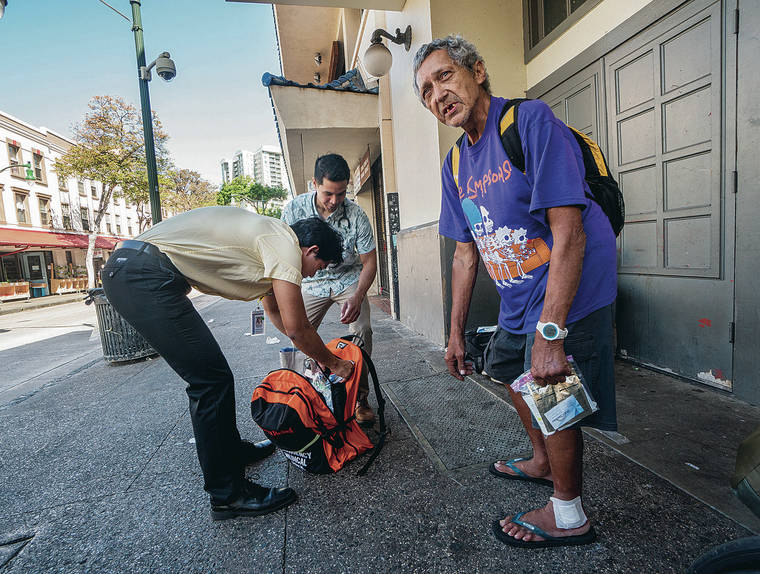
DENNIS ODA / DODA@STARADVERTISER.COM
Volunteer medical students Zachary Tom, left and Kaily Kuikahi get supplies to treat Anthony Bonilla.
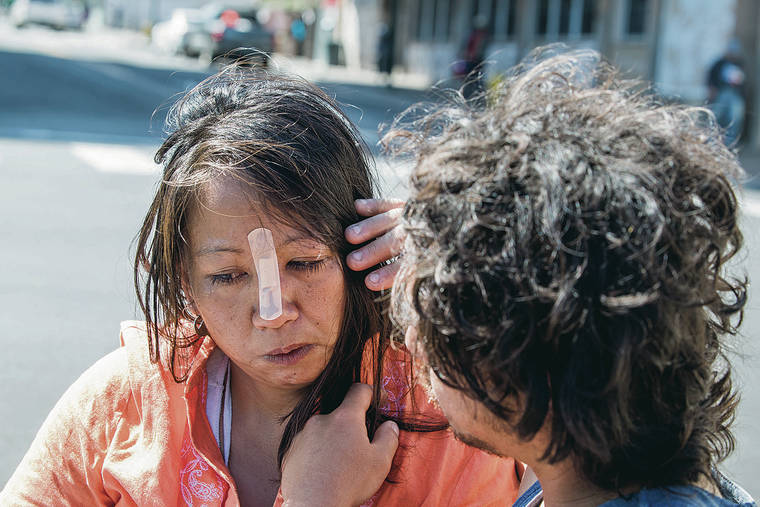
DENNIS ODA / DODA@STARADVERTISER.COM
Anthony Sevache checks the bandage he just applied to the nose of his girlfriend Evansville Luad. Luad was hit in the face by another homeless person.
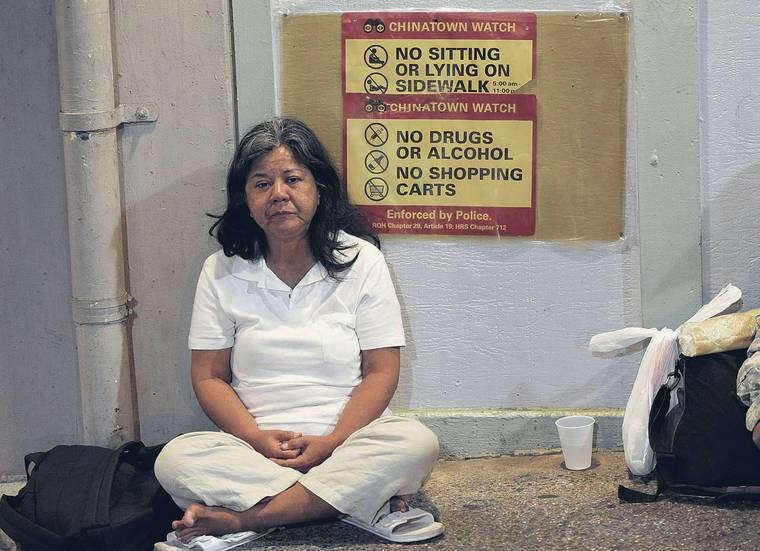
BRUCE ASATO / BASATO@STARADVERTISER.COM
Carol Akemoto settles in for the night on a North Pauahi Street sidewalk next to Chinatown Watch signs.
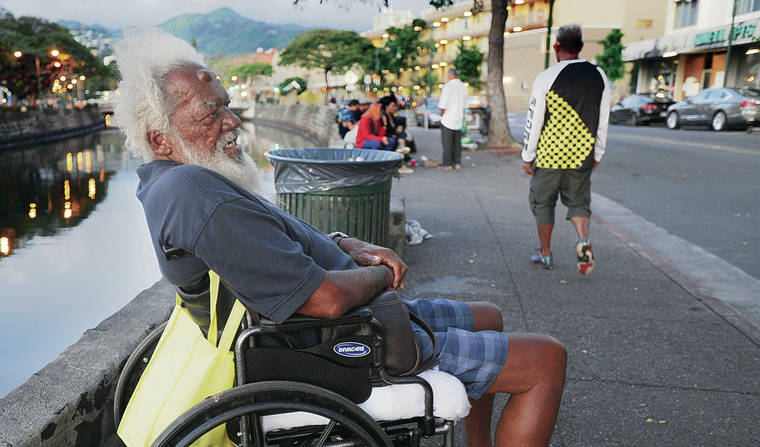
BRUCE ASATO / BASATO@STARADVERTISER.COM
Johnny Robert Jr. sat in his wheelchair on a River Street sidewalk last month. “Most of these guys are drinking and doing drugs. Me? I still drink, but I’m down to two 40-ounce Colt 45s (malt liquor) a day,” the 71-year-old Navy veteran said.
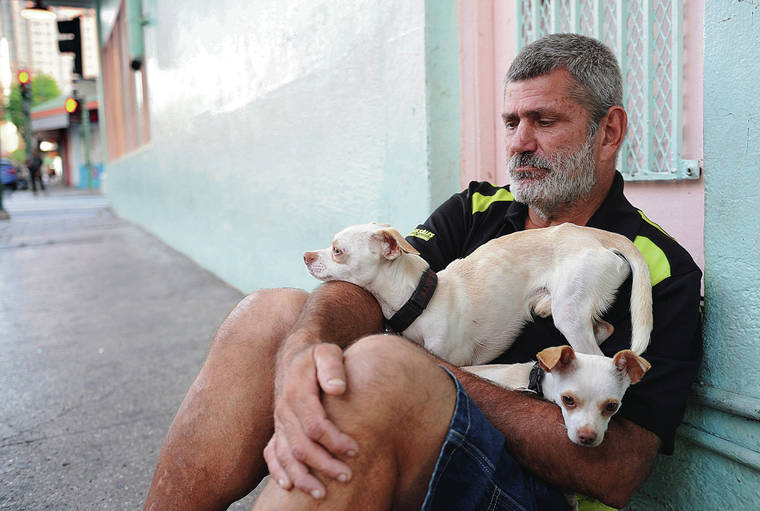
BRUCE ASATO / BASATO@STARADVERTISER.COM
Eddie Launius sat on a North Pauahi Street sidewalk last month with his two dogs Koipu and Boy waiting for the River of Life Mission to begin distributing food. Launius lives in the city’s Hale Mauliola transitional housing project on Sand Island.
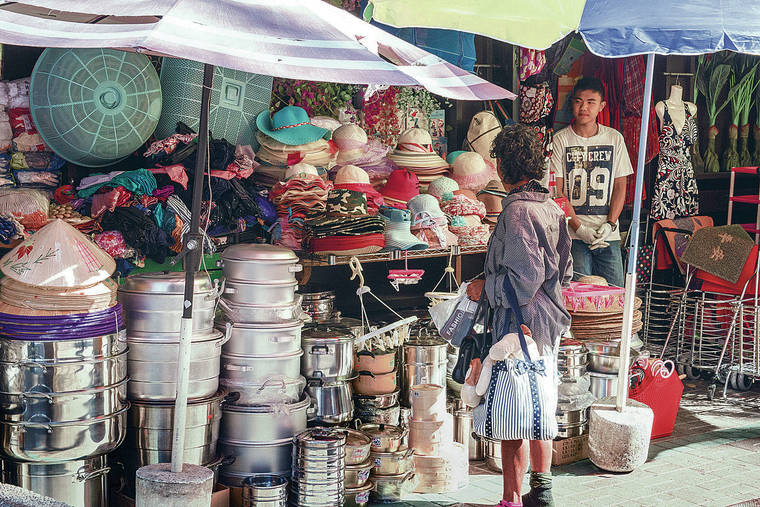
CRAIG T. KOJIMA / CKOJIMA@STARADVERTISER.COM
Leman Key, who said she has been homeless for 23 years, shops at Kekaulike Market.
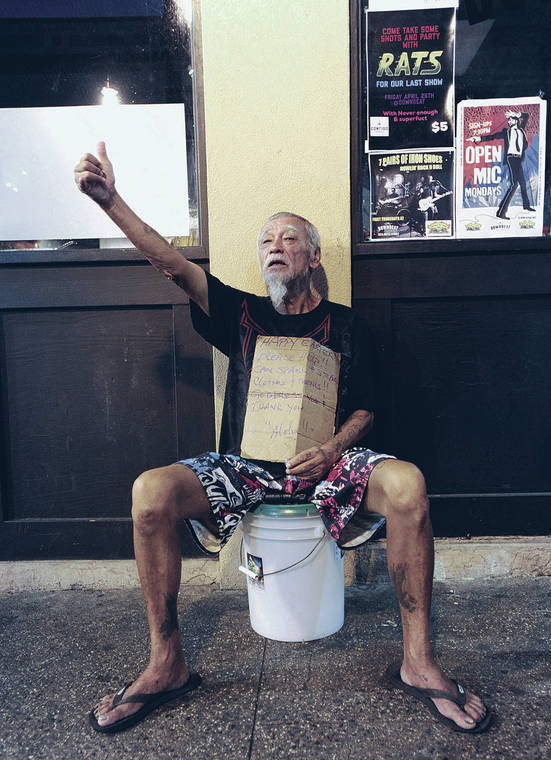
BRUCE ASATO / BASATO@STARADVERTISER.COM
Mikey Alapaki holds up a sign that reads, “HAPPY EASTER!! Please Help!! Can Spare $5.00 for Clothes & Meals!! God Bless You & Thank You. Aloha!!” on a North Hotel Street sidewalk.








THIRD OF FIVE PARTS
Leman Key said she’s been homeless for 23 years, but could not remember her age.
Key said she’s Hawaiian and either 46 or 47 years old. But, with missing teeth due to smoking crystal methamphetamine, Key could easily pass for 60.
She showed up in Chinatown’s Kekaulike Market on a recent morning with only tattered and mismatched socks on her feet that exposed some of her toes.
Asked what happened to her shoes, Key said she “turned a trick” earlier in the morning as if prostituting herself explained her missing footwear.
Honolulu Star-Advertiser reporter Dan Nakaso spent three weeks in Chinatown — from the early hours to late at night — interviewing business owners, police, homeless people, residents, tourists and government officials about homelessness in the historic district.
Don't miss out on what's happening!
Stay in touch with breaking news, as it happens, conveniently in your email inbox. It's FREE!
Wednesday: Honolulu police officers’ perspective
Thursday: What’s next for Chinatown?
She bumped into Lt. Gov. Josh Green, who bought her new slippers and a pair of shoes costing Green $25.
“She said she turned a trick this morning and she’s regularly raped,” Green said. “She buys a new purse every day for $2 because she’s always getting ripped off. Each night she’s vulnerable to getting raped or robbed.”
As Green spoke, Key dropped her latest $2 purse to the ground and kept digging through it to show off a puppy that did not exist.
“She has delusions consistent with her schizophrenia,” said Green, an emergency room physician.
Nearby, six tourists from Iowa visiting Kekaulike Market said they were not prepared for the number of homeless people they had seen on Oahu.
“We were surprised,” said Jose Molina, who joined his wife and two other couples on their Hawaii vacation. “There’s a lot of homeless people.”
>> Chinatown business owners frustrated with homeless
>> Chinatown grapples with surge in homeless
RELATED PHOTOS
>> Homeless in Honolulu’s historic Chinatown district
Medical assistance
University of Hawaii medical students Kaily Kuikahi, 27, of Ewa Beach, and Zachary Tom, 24, of Aiea, walked out of the year-old Joint Outreach Center on North Hotel Street equipped with hygiene kits to ease introductions with homeless people and a backpack full of medical supplies to treat wounds that can turn septic on the street or take months to heal, if not longer.
On the mauka side of North Hotel Street, just across from Kekaulike Market, they met Anthony Bonilla, 65, who stood against a wall wearing a bandage on his left ankle, where Bonilla said he was bitten by “a flesh-eating bug” 13 months before and had yet to heal.
Bonilla said he’s been homeless “on and off for six, seven years” and spent the previous night sleeping on Bishop Street.
After getting a quick examination and a fresh bandage, Bonilla called the work of the UH medical students “a beautiful thing they do. Very helpful for the homeless.”
Out of a handful of homeless people invited back to the JOC by Kuikahi and Tom on a recent 3-hour shift, only Bonilla showed up and was given a more thorough examination on a medical table.
The work of both medical professionals and students at the JOC is designed to earn trust from Chinatown’s homeless so they, ideally, take the next steps to receive further services at the Institute for Human Services in nearby Iwilei.
Some 1,486 unduplicated patients were treated at both IHS and at the JOC as of April 8 — far more than the 172 homeless people in Chinatown who were counted by Institute for Human Services outreach workers in all of 2018.
The 45 med students who began working out of the JOC in July were already hard-wired to help long before they hit the streets of Chinatown looking for the wounded and vulnerable.
“Physicians should have a responsibility for caring for vulnerable populations. … And it makes them more compassionate doctors,” said Dr. Teresa Schiff, medical director for the UH John A. Burns School of Medicine’s Hawaii Home Project.
On their applications to JABSOM, Shiff said, “almost without exception there’s some variation of wanting to make the world a better place.”
While Bonilla took the step of walking into the JOC, Kuikahi and Tom were less successful with Anthony Savache, 28, and his girlfriend Evansville Luab, 33, who had spent the night in a tent on River Street.
Luab emerged from their tent with an open wound between her eyes and another wound on her right ankle.
“A couple of weeks ago during a brawl, she was bashed in the head with a stick,” Tom said. “Twice — right between the eyes.”
While residents and merchants complain about unwanted and illegal homeless activity, an unknown number of homeless people in Chinatown, such as Key, are also vulnerable and preyed upon.
In an email to the Honolulu Star-Advertiser, homeless Chinatown resident Nathaniel Staudt wrote that he has a mental disability and hears voices.
“I hear voices inside my head and sometimes those voices seem to come from outside my head,” Staudt wrote. “It is to the point now that I can not tell real voices from those my brain fabricates.
“I have been assaulted numerous times and get death threats countless times each day,” Staudt wrote. “People talk under their breath or as they walk away. Spit at my feet and groups of people will cross the streets just to stand in my way so I have to detour.
“I am scared for my safety. It’s just a matter of time till the verbal harassment turns physical,” he said. “I don’t know what else to do. … I need help and have no one to turn to.”
Self-inflicted problems
Some of the problems of Chinatown’s homeless are self-inflicted, said Johnny Robert Jr., 71, who sat in a wheelchair on River Street on a recent night.
Robert looked at the tents and encampments lining River Street and said, “Most of these guys are drinking and doing drugs. Me? I still drink, but I’m down to two 40-ounce Colt 45s (malt liquor) a day.”
He said he’s a Navy veteran who was assigned to two different U.S. warships in Vietnamese waters starting in 1969.
James Melon, 43, has been homeless on Oahu since he arrived in 2015 for an auto repair job.
He now wants to move back home to Tampa, Fla., because being homeless in Hawaii is “bad, real bad,” Melon said. “It’s a nightmare. Not too many people want to help you.”
Tilena Wilkins, 51, calls herself a “black Hawaiian from Makaha.”
She’s been homeless for more than 20 years and on a recent morning came to River of Life Mission for a hot shower and donated clothes.
Wilkins is what’s considered a “sheltered” homeless person and takes turns spending the night with different friends.
“I won’t live on the street because I’ll get raped, probably,” Wilkins said.
Eddie Launius is also considered “sheltered,” but still homeless.
He said he’s been homeless for 40 of his 58 years and grew up on the streets of Chinatown, where he got a rough education.
“I had my first fight at Smith’s Union Bar,” Launius said.
In early April Launius said he and his girlfriend and Launius’ two dogs — Koipu and Boy — moved into the city’s Hale Mauliola transitional housing project on Sand Island, where housing is made out of converted shipping containers.
It’s the city’s first project to accept pets — one of the barriers that homeless people frequently cite for not moving into a shelter, which they also have to pay for.
“The city is really pushing people out and into shelters,” Launius said.
He likes coming back to Chinatown to visit. But for now, with a hard roof over his head, Launius said, “it’s working out for me.”
On a recent night on North Hotel Street, things were not working out so well for Mikey Alapaka, 63, who held up a cardboard sign asking for $5 “for clothes and stuff.”
After several hours, Alapaka produced his earnings for the night: three dimes and three nickels adding up to 45 cents.
Across the street, Kevin Broadous worked security at Bar 35, where he sees Alapaka pan-handling every night.
“There are some crazies,” Broadous said. “The reason I’m here is because we screen people from coming in. You need proper ID and you gotta have shoes on. You’ve gotta have a shirt on.”
Around the corner, on North Pauahi Street, a dozen people sat or lay down on the sidewalk. One woman snored as she slept on garbage, using a tray of food for a pillow.
“I don’t know where they expect everyone to sit and stay,” said Laurice Alapai, 46.
Alapai has been homeless “off and on for 17 years,” and said, “I live in the river.”
Alapai suggested that shelter life does not work for her.
“When you’re out here a long time, it’s hard to acclimate to rules,” she said.
As Alapai spoke, Carol Akemoto, 55, slouched on the sidewalk next to a sign created by frustrated Chinatown business owners who make up the “Chinatown Watch” that read:
“No sitting or lying on sidewalk;” “No drugs or alcohol;” and “No shopping carts.”
Asked where she would sleep that night, Akemoto pointed to the sidewalk beneath her and said, “right here sounds good.”
BY THE NUMBERS
594
Number of homeless people counted in January 2018 in the “downtown” area, which stretches from Halawa Heights through Chinatown, downtown and into Kakaako
172
Number of homeless people living in Chinatown that Institute for Human Services’ outreach workers counted in all of 2018.
158
Number of Chinatown homeless people who have accessed homeless services through IHS since 2018.
Sources: Annual Point in Time Count, Institute for Human Services





